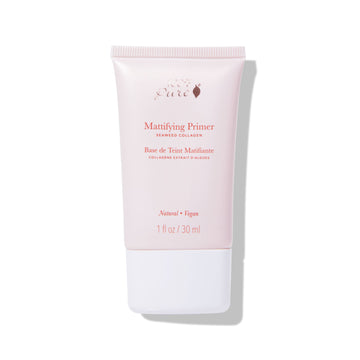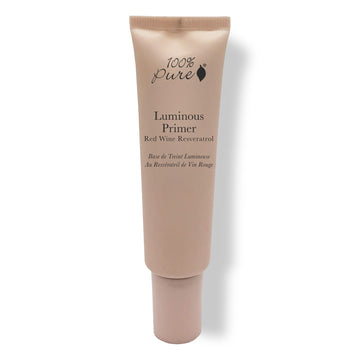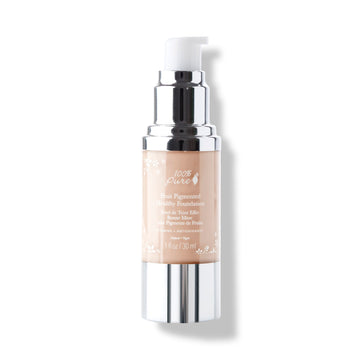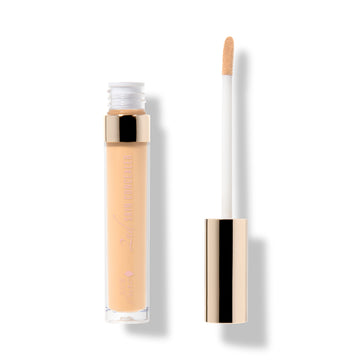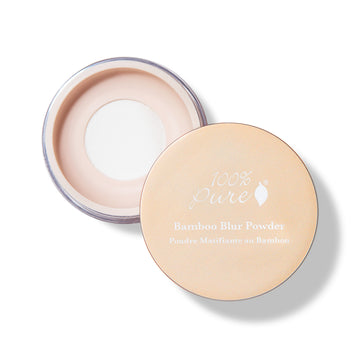Discover the Game-Changing Beauty Hack for a Smooth, Long-Lasting Look
Posted on March 23, 2025 Written by: 100% PURE®
Ever wondered why your makeup looks flawless in selfies but melts off in real life? That’s the classic Instagram vs. Real Life Struggle! The secret to long-lasting, smooth makeup? A good primer. Think of it as the base that grips your makeup, keeping it fresh all day.
Whether you're battling oily skin, dryness, or large pores, there’s a primer for you—hydrating, mattifying, pore-filling, or color-correcting.
The right one makes all the difference, ensuring your makeup stays put from morning coffee to late-night selfies. Ready to find your perfect match? Let’s dive into the world of primers!
What Is a Makeup Primer?
A makeup primer is a base product designed to create a smooth surface for the foundation, ensuring it applies evenly and lasts longer. It works by filling in pores, controlling oil or dryness, and forming a lightweight barrier between your skin and makeup. The key ingredients in primers, like silicones (such as dimethicone), help blur imperfections and prevent the foundation from settling into fine lines. Hydrating primers contain glycerin or hyaluronic acid while mattifying ones use ingredients like silica to control shine.

What Does a Primer Do? (Breaking It Down)
A primer is like a magic filter for your skin, creating the perfect base for your makeup. Here’s how it works:
Fills pores and fine lines– Silicone-based primers smooth out skin texture, creating an even surface for foundation.
Controls oil– Mattifying primers absorb excess oil, preventing shine and keeping your makeup intact.
Hydrates skin– Moisturizing primers lock in hydration, preventing the foundation from clinging to dry patches.
Increases makeup longevity– By gripping foundation, primers help your makeup stay fresh all day.
Acts as a color corrector– Some primers contain color-correcting pigments to neutralize redness or dullness.
Choosing the Right Primer for Your Skin Type
Finding the perfect primer starts with understanding your skin’s needs. A well-matched primer not only enhances makeup application but also addresses specific skin concerns:
Oily Skin
If you struggle with excess shine and makeup that slides off, a mattifying primer is your best bet. The 100% PURE Mattifying Primer helps absorb oil, minimize pores, and keep your skin looking fresh all day.
Dry Skin
Hydrating primers infused with botanical extracts help nourish and smooth the skin, preventing the foundation from settling into dry patches. Look for ingredients like aloe and hyaluronic acid for maximum moisture.
Combination Skin
A balancing primer ensures that oily areas stay matte while dry areas remain hydrated, creating an even, natural finish.
Sensitive Skin
Gentle, clean formulas with no harsh chemicals help prevent irritation. The 100% PURE Luminous Primer is a great option, providing a smooth, radiant base while soothing sensitive skin with natural ingredients.
Complete Your Makeup Routine with 100% PURE.
Once you’ve prepped your skin with the right primer, complete your flawless look with these must-have 100% PURE products:
Foundation: Fruit Pigmented® Healthy Foundation– A full-coverage foundation made with antioxidant-rich fruit pigments to nourish and protect your skin while providing a flawless finish.
Concealer: 2nd Skin Concealer– Lightweight and blendable, this serum-like concealer offers natural-looking coverage with hydrating plant-based ingredients.
Setting Powder: Bamboo Blur Powder– A finely milled, weightless powder that blurs imperfections and locks in makeup for a long-lasting, airbrushed look.
With the right primer and makeup essentials, you can achieve a smooth, radiant complexion that lasts all day!
How to Apply Primer Like a Pro
Applying primer the right way can make all the difference in how your makeup looks and lasts. Follow these expert tips to ensure a flawless base:
1. Use the Right Amount
A little goes a long way! Apply a pea-sized amount of primer—too much can cause pilling or make your foundation slip.
2. Apply to Clean, Moisturized Skin
Always start with freshly washed and hydrated skin. Let your moisturizer fully absorb before applying primer to prevent product buildup.
3. Warm It Up and Press It In
Instead of rubbing, gently press and smooth the primer into your skin with your fingers. This ensures even coverage without disrupting skincare underneath.
4. Wait Before Applying Foundation
Give your primer 30–60 seconds to set before layering the foundation. This prevents the products from mixing and causing patchiness.
5. Choose the Right Formula for Your Skin Type
Silicone-based primers work best with silicone-based foundations.
Water-based primers pair well with lightweight, dewy foundations.
Common Primer Mistakes to Avoid
❌ Applying too much product—this leads to pilling.
❌ Skipping skincare—primer works best on well-prepped skin.
❌ Rubbing it in—pressing ensures better absorption and longevity.
Mastering these techniques will help your primer do its job, keeping your makeup fresh and flawless all day long!
The Science of Primer: How It Works with Your Skin
Primer isn’t just an extra step—it’s essential for ensuring smooth, long-lasting makeup. Different formulas contain key ingredients tailored to specific skin needs. Silicone-based primers, like those with dimethicone, create a breathable barrier that fills fine lines and pores, helping the foundation glide on evenly and stay put. Water-based primers are lightweight and ideal for dry or combination skin, offering hydration without clogging pores. Hydrating primers with glycerin and hyaluronic acid lock in moisture, preventing the foundation from looking cakey or flaky.
A study in Clinical, Cosmetic, and Investigative Dermatology examined a facial primer’s effects on mild-to-moderate hyperpigmentation and fine lines from photoaging. Results showed immediate improvements after the first use, with participants experiencing progressive enhancements over 12 weeks. The primer also created a smoother makeup base while benefiting skin health. Participants rated it highly, proving its effectiveness in both cosmetics and skincare.

Can You Skip Primer? (Pros and Cons of Going Without It)
Primer is often seen as an optional step, but skipping it can impact how your makeup looks and lasts. Whether you need primer depends on your skin type, makeup routine, and desired finish.
When You Can Skip Primer
1. If your foundation already contains built-in priming properties.
2. When wearing minimal or lightweight makeup that doesn’t require long wear.
3. If your skin is naturally balanced and doesn’t need oil control or extra hydration.
When a Primer is Necessary
1. If you have oily skin, a mattifying primer helps control shine and prevents makeup from sliding off.
2. For dry skin, hydrating primers prevent the foundation from clinging to dry patches.
3. If you struggle with visible pores, fine lines, or uneven texture, a smoothing primer creates a flawless base.
4. When wearing makeup for long hours, primer enhances longevity, preventing fading or creasing.
Skipping primer might work for some, but for a polished, long-lasting finish, it’s a step worth considering!
FAQ Section
What does primer do for your makeup?
Primer preps your skin for foundation by creating a smooth, even surface, filling in fine lines and pores, and helping makeup adhere better. It also enhances longevity, controls oil, hydrates dry areas, and can even color-correct redness or dullness.
How long should you wait after applying primer?
You should wait 30–60 seconds after applying primer before moving on to the foundation. This allows the primer to set properly, ensuring better adherence and preventing patchiness.
Can primer be worn alone?
Yes! Many primers blur imperfections, control shine, or add a subtle glow, making them great for a natural, no-makeup look.
Does primer replace moisturizer?
No, primer doesn’t replace moisturizer. While some primers offer hydration, moisturizer is essential for skin health, especially for dry skin.
How do I know if my primer is compatible with my foundation?
Match water-based primers with water-based foundations and silicone-based primers with silicone-based foundations to avoid separation or pilling. Check ingredient lists—if a primer contains silicones (like dimethicone), pair it with a silicone-based foundation.
Get Your Primer Today
A great makeup look starts with a strong foundation—literally! Primer bridges the gap between skincare and makeup, ensuring a smooth, long-lasting finish while addressing concerns like oiliness, dryness, and uneven texture. Whether you want a matte, dewy, or natural look, the right primer enhances your foundation’s performance and keeps your skin looking fresh all day.
If you’ve ever struggled with fading, creasing, or patchy foundation, it might be time to upgrade your routine with the perfect primer. 100% PURE offers a range of clean, skin-loving primers tailored to every skin type. Discover yours today and unlock a flawless, long-lasting makeup look! Shop now at 100% PURE.
- Tags: March-2025
We carefully hand-select products based on strict purity standards, and only recommend products we feel meet this criteria. 100% PURE™ may earn a small commission for products purchased through affiliate links.
The information in this article is for educational use, and not intended to substitute professional medical advice, diagnosis, or treatment and should not be used as such.













